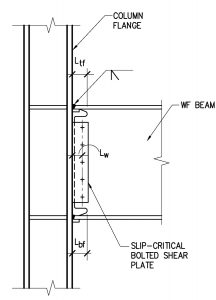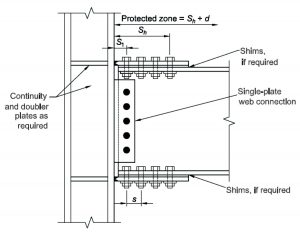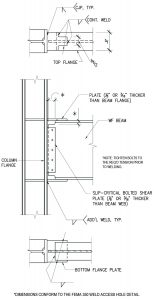In May 2016, the American Institute of Steel Construction (AISC) published ANSI/AISC 358-16, Prequalified Connections for Special and Intermediate Steel Moment Frames for Seismic Applications. It has been a significant influence on the research and development of products by government agencies, universities, and engineering research centers. Much of the research was done soon after the failure of steel moment frames during the 1994 Northridge Earthquake.
These Prequalified Connections were developed to establish standards and aid in the design of building structures subjected to seismic loading. There is a total of nine Prequalified Connections, including four proprietary connections (#5, 6, 7 and 8), which are standalone designs and included herein for information only:
- Reduced Beam Section (RBS) Moment Connection
- Bolted Unstiffened and Stiffened Extended End-Plate Moment Connections
- Bolted Flange Plate (BFP) Moment Connection
- Welded Unreinforced Flange-Welded Web (WUF-W) Moment Connection
- Kaiser Bolted Bracket (KBB) Moment Connection
- ConXtech ConXL Moment Connection
- SidePlate Moment Connection
- Simpson Strong-Tie Strong Frame Moment Connection
- Double-Tee Moment Connection
Vertical Beam Shear Distribution
Structural engineers have made design assumptions for generations, most of which have been effective and conservative, but some assumptions have yielded less than favorable results. The design assumption we made on the steel moment connection is a prime example; we simply assume the beam shear transfer to the column by the beam web and shear tab or clip angles, and the moment transfer to the column by tensile and compressive forces in the beam flanges. From Figure 1, we can see that there are three points of contact between the beam and the column, i.e., connections at the top and bottom flanges and the beam web. At each point of contact, a portion of the total beam shear will be distributed to the column in accordance with their relative stiffness. The shear distribution can be determined based on the following equations:
d = df + dv = PL3 /12EI + 1.2 PL/GA (Eqn. 1) (Both ends are considered fixed)
where d = total deflection, df = deflection due to bending, dv = deflection due to shear deformation, P = applied force, L = distance between both ends, A = cross section area, I = moment of inertia, E = modulus of elasticity, and G = shear modulus. shear modulus, G = E/2(1+µ), where µ = Poisson’s ratio. For structural steel E = 29 x 106 psi, and µ = 0.30, let P = unit force = 1, and equation (1) becomes
d = L3/384I + L/9.3A (Eqn. 2)
Since stiffness is the inverse of the deflection, k = 1/d, we can determine the relative stiffness of each connecting element (ktf, kw, and kbf) with respect to the total sum of the stiffness, and thereby obtain the shear distribution at each location.
Are the beam shears distributed to the beam flanges significant? Yes, they are. As an example, a W24x68 beam connects to a column flange by a 7⁄16-inch x 18-inch shear tab, with a CJP weld to the column and slip-critical bolts to the beam web; beam flanges are groove-welded to the column, and the weld access holes conform to the FEMA 350 detail. From Figure 1, let Lw = 3 inches, Ltf = Lbf = 2.63 inches (FEMA 350) and, using the connecting element stiffness determined from the equations above, the author finds that the portion of the beam shear that goes to the beam web is about 83%, leaving 17% to the beam flanges or 8.5% for each beam flange. This is an average shear on the weld/beam flange rectangular section, and the maximum shear stress at the center would be 50% greater. According to the Hencky-von Mises principal stresses relationship, if we combine this shear stress with the design tensile/compressive stress, we would get an even larger stress (principal stress). This additional stress is significant and should be considered/included in the design of the connection. It should be noted that the pre-Northridge moment connections had very short weld access holes, thus resulting in very rigid connecting elements between the column and the beam flanges. Therefore, a larger amount of beam shear would be transferred through the beam flanges.
Weld Shrinkage Residual Stresses
In structural steel construction, a welded connection has some advantages over a bolted connection. It also has many disadvantages, a couple of which are: a) welded joints are highly prone to cracking under fatigue loading, and b) large residual stresses and distortion are developed in welded connections. The magnitude of the residual stresses varies greatly depending upon the joint restraint, geometry, material thermal properties, welding process, and more. If the parts to be joined are free to expand and contract, then the residual stresses would be minimal. However, if one or both parts of the joining members is/are subjected to external restraints, as in the case of direct welding between beam and column, then a high level of residual stresses would occur as a result.
It should be noted that, in a general welding process, residual stresses are increased when an increased number of passes are made. This means that the thickness of the beam flange should be minimized.
Beam to Column
Only Reduced Beam Sections (RBS) and Welded Unreinforced Flange-Welded Web (WUF-W) Moment Connections are direct beam-to-column connections. In the actual field construction, the beam flange welded joints will be subjected to weld shrinkage residual stress (longitudinal and transverse directions). The residual stress in the weld transverse direction is substantial due to external restraint during welding. Neither side of the welded joint is free to move, i.e., the beam is restrained by the other end connection and other framing. Although both the RBS and WUF-W are prequalified by laboratory testing, the validity of the testing is questionable since it did not represent the actual building frame construction. In preparing the test specimens, there was no external restraint in the welding of beam-to-column specimens or the cyclic loading tests.
The Bolted Flange Plate (BFP) moment connection (Figure 2) employs the flange plates as connecting elements, and the plates are free to move when welded to the column; therefore, only minor residual stress exists at the welded joint and may be considered negligible.
WFP Moment Connection
As shown in Figure 3, the author presents Welded Flange Plate (WFP) moment connection design as an alternative to the limited number of non-propriety moment connections currently in use. It has not been tested for prequalification but can be used for moment frames subjected to wind load and for structural steel systems not specifically detailed for seismic resistance. The WFP moment connection is similar to the BFP moment connection; the flange plates are fillet-welded to the beam flanges instead of bolted. The flange plates and the web shear plate can be made thicker than the beam flange and the beam web, respectively, to shift the plastic hinge away from the column. The flange plate shall be welded to the column flange with double J or bevel T-joint CJP groove weld to minimize weld shrinkage residual stress and distortion. The geometry of the top flange plate is configured such that, when welded to the beam flange, the high tearing stress is minimized. An additional weld between the flange plate and the beam flange may be added in the high tearing stress area to minimize the tearing stress further. The depth of the web shear plate should be made as deep as practically possible to maximize its stiffness and thus capture most of the beam shear force. Since the WFP connection is very similar to the BFP connection, the prequalification limit on the maximum beam depth, weight, and flange thickness should be the same, i.e., 36 inches (W36), 150 lbs/ft and 1 inch respectively. However, it is the author’s opinion that the limit should be 30 inches (W30), 108 lbs/ft and ¾ inch respectively to minimize the residual stress in the welded joint (the thicker the beam flange, the higher the residual stress). It should be noted that the cost of fabrication and erection seems comparable to that of the BFP moment connection.
Conclusions
- The vertical beam shear distributed to the column through the beam web and top and bottom flanges, based on their relative stiffness, should be considered in the design of connections.
- A high level of weld shrinkage residual stress exists when the beam and column are directly welded together; this type of connection should be avoided until the magnitude of the residual stress is better defined, and the testing apparatus and process are made to represent the actual field construction.
- With additional shear and residual stress at the welded joints (with or without flange plates), reduction of the joint moment capacity should be considered.
- The WFP moment connection is a prime candidate for prequalification. If tested and prequalified, it will provide an additional design option for structural engineers.▪
References
AISC (2016), Prequalified Connections for Special and Intermediate Steel Moment Frames for Seismic Applications (ANSI/AISC 358-16), American Institute of Steel Construction, Chicago, IL
AISC (2016), Seismic Provisions for Structural Steel Buildings (ANSI/AISC 341-16), American Institute of Steel Construction, Chicago, IL
AISC (2010), Specification for Structural Steel Buildings (ANSI/AISC 360-10), American Institute of Steel Construction, Chicago, IL.
AISC (2011), Steel Construction Manual, 14th Edition, American Institute of Steel Construction, Chicago, IL.
AWS (2001), Welding Handbook – 9th Edition, Volume 1, American Welding Society, Miami, FL.
Benjamin, J. R. (1959), Statically Indeterminate Structures, McGraw-Hill Book Company Inc., New York, NY.
Bresler, B., Lin, T. Y. and Scalzi, J. B. (1968), Design of Steel Structures, 2nd ed., John Wiley & Son, New York, NY.
Brockenbrough, R. L. and Johnston, B. G. (1974), USS Steel Design Manual, United States Steel Corporation, Pittsburgh, PA.
Den Hartog, J. P. (1949), Strength of Materials, McGraw-Hill Book Company Inc., New York, NY.
Hornbach, D.J., Prevéy, P.S., Blodgett, M. (2004) Practical Application of Nondestructive Residual Stress Measurements by X-ray Diffraction, AFRL/MLLP Proceedings of ASNT Fall Conference, Las Vegas, NV.
Liu J. (1997), Handbook of Measurement of Residual Stresses, Society for Experimental Mechanics, Fairmont Press.
Mahmoudi, A.H., Hossain, S., Truman, C.E., Smith, D.J., Pavier, M.J., “A new procedure to measure near yield residual stresses using the Deep-Hole Drilling technique,” Journal of Experimental Mechanics, Vol. 49, No. 4, 2009.
Sabol, T.A. et al. (1996) Overview of the AISC Northridge Moment Connection Test Program, Paper No. 857 Elsevier Science Ltd.



